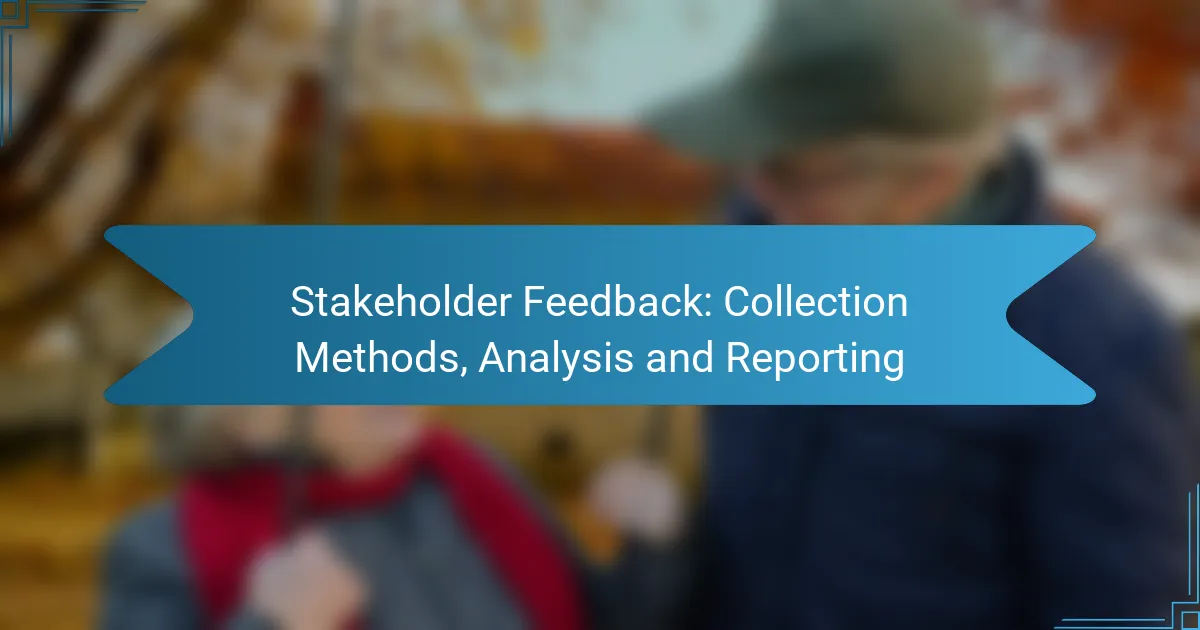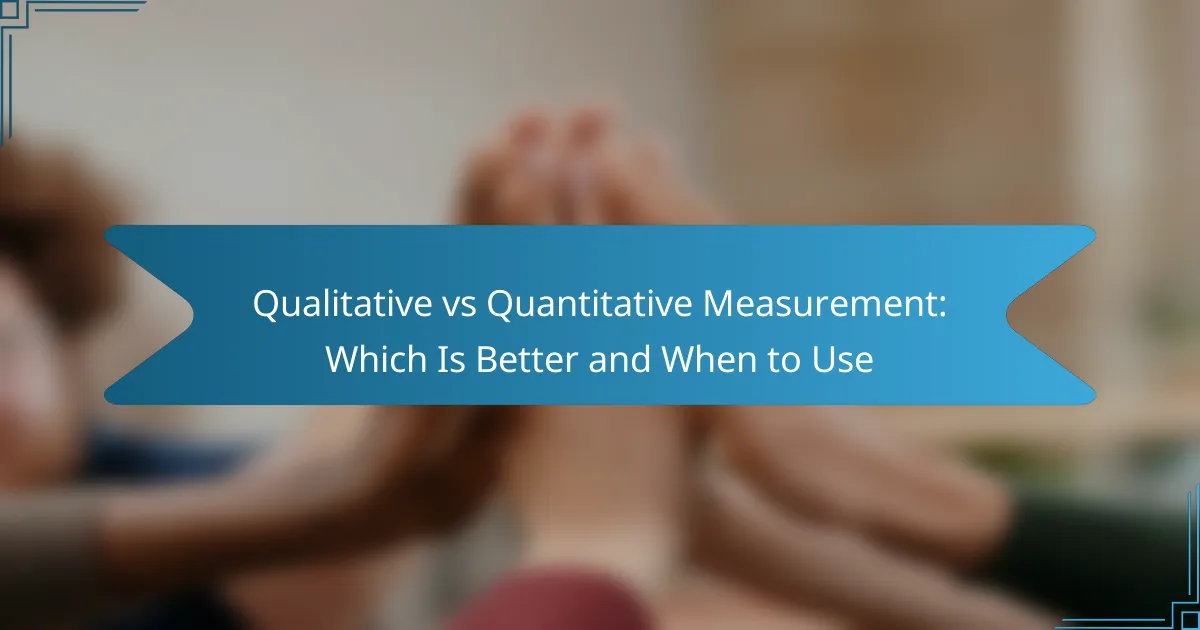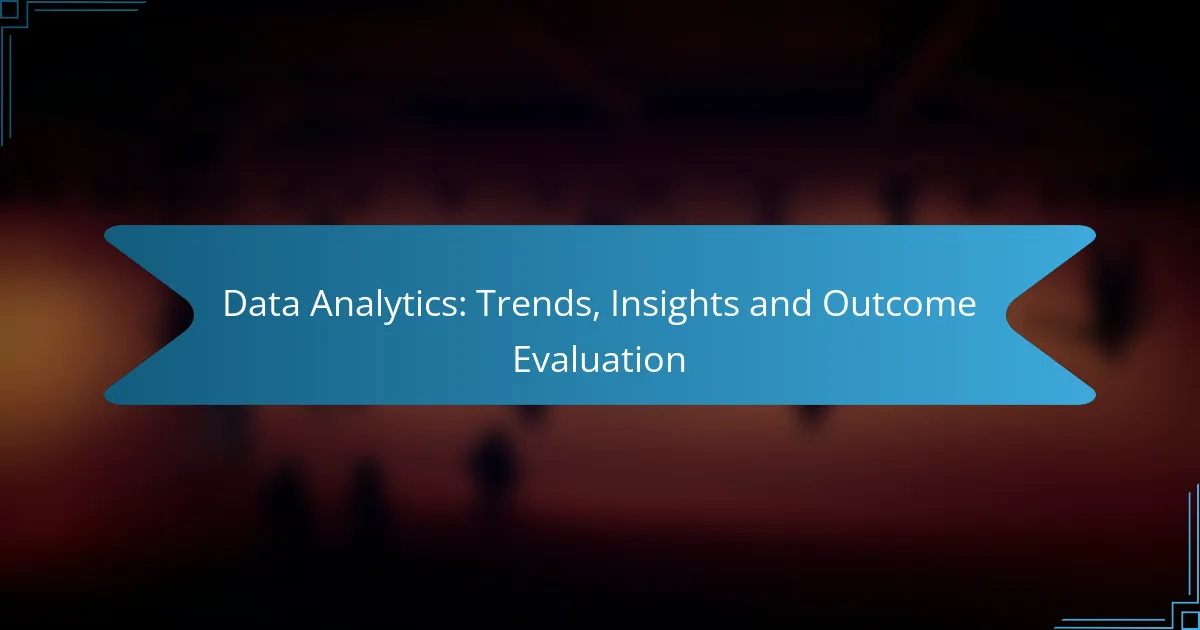Collecting stakeholder feedback is crucial for organizations seeking to understand and improve their practices. Utilizing diverse methods such as surveys, interviews, and social media listening can yield valuable insights. Analyzing this feedback effectively allows organizations to identify trends and opportunities for enhancement, while clear and concise reporting ensures that the findings are accessible and actionable for decision-makers.
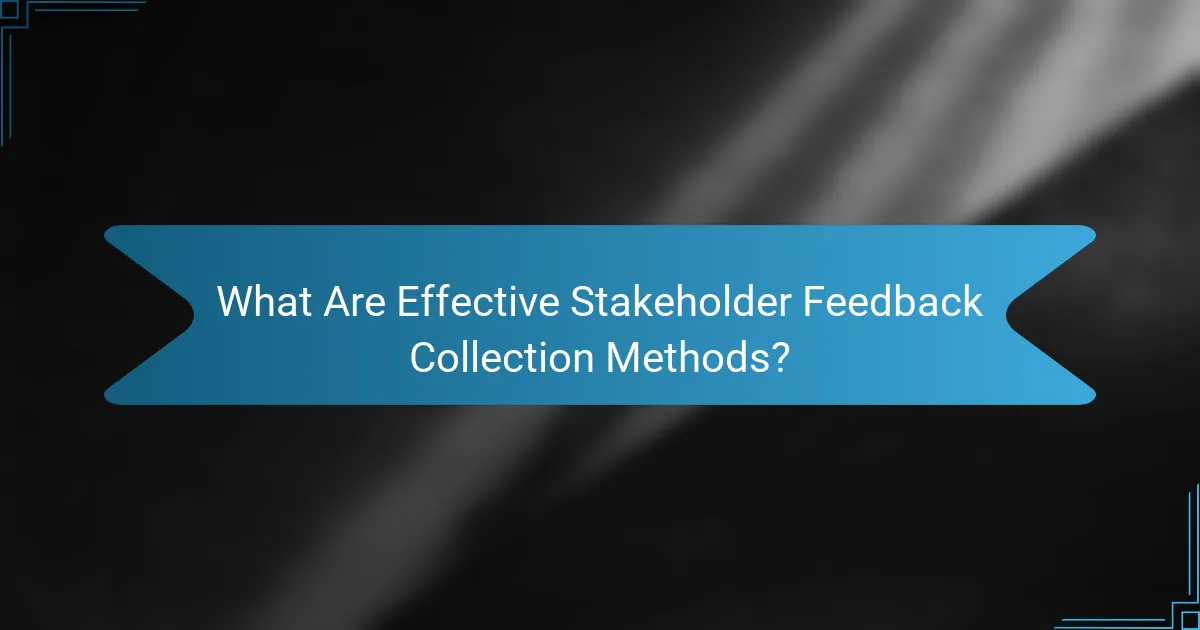
What Are Effective Stakeholder Feedback Collection Methods?
Effective stakeholder feedback collection methods include surveys, interviews, focus groups, online feedback tools, and social media listening. Each method has unique advantages and considerations that can help organizations gather valuable insights from their stakeholders.
Surveys
Surveys are structured questionnaires that can be distributed to a large audience, making them a cost-effective way to gather feedback. They can be conducted online or via paper forms and typically include multiple-choice, rating scale, or open-ended questions.
When designing surveys, keep them concise to encourage completion. Aim for 10-15 questions, and consider using tools like Google Forms or SurveyMonkey for easy distribution and analysis. Avoid leading questions to ensure unbiased responses.
Interviews
Interviews involve direct, one-on-one conversations with stakeholders, allowing for in-depth exploration of their opinions and experiences. This method is particularly useful for gathering qualitative data and understanding complex issues.
Prepare open-ended questions to facilitate discussion, and consider recording interviews (with permission) for accurate analysis. Aim for 30-60 minutes per interview to maintain engagement without overwhelming participants.
Focus Groups
Focus groups bring together a small group of stakeholders to discuss specific topics guided by a facilitator. This method encourages interaction and can reveal diverse perspectives on issues.
Limit focus groups to 6-10 participants to ensure everyone has a chance to contribute. Sessions should last about 1-2 hours, and it’s beneficial to have a clear agenda to keep discussions on track. Consider using a neutral location to promote open dialogue.
Online Feedback Tools
Online feedback tools, such as feedback widgets or customer experience platforms, allow stakeholders to provide input at their convenience. These tools can be integrated into websites or apps, making it easy for users to share their thoughts.
Choose tools that offer analytics features to track trends over time. Ensure the feedback process is simple and accessible, as this increases the likelihood of participation. Regularly review and act on the feedback collected to demonstrate responsiveness.
Social Media Listening
Social media listening involves monitoring social media platforms for mentions of your organization, products, or services. This method provides real-time insights into stakeholder sentiments and trends.
Utilize tools like Hootsuite or Brandwatch to track conversations and analyze sentiment. Engage with stakeholders by responding to comments and questions, which can enhance relationships and build trust. Be mindful of privacy and ethical considerations when analyzing public data.
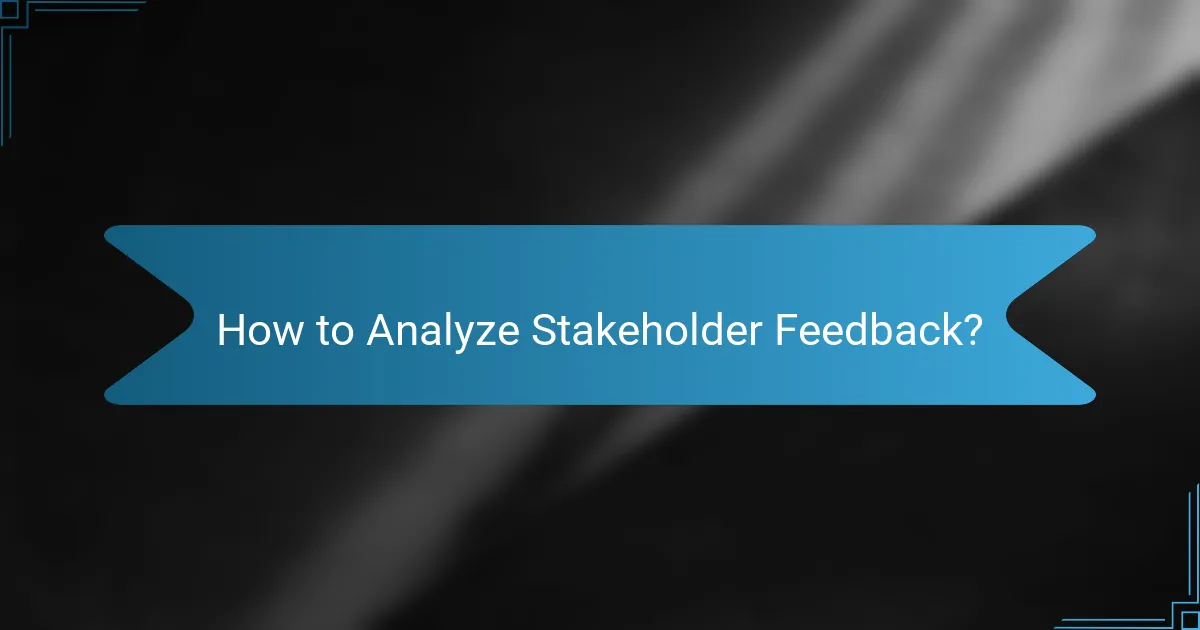
How to Analyze Stakeholder Feedback?
Analyzing stakeholder feedback involves systematically reviewing and interpreting the information gathered to inform decision-making. Effective analysis helps identify trends, issues, and opportunities for improvement based on stakeholder perspectives.
Qualitative Analysis
Qualitative analysis focuses on understanding the underlying themes and insights from stakeholder feedback. This method often involves reviewing open-ended responses, interviews, or focus group discussions to capture nuanced opinions and sentiments.
To conduct qualitative analysis, categorize feedback into themes and identify patterns. Techniques such as coding responses or using software tools can facilitate this process. Look for recurring phrases or concepts that highlight stakeholder priorities.
Quantitative Analysis
Quantitative analysis involves measuring and interpreting numerical data derived from stakeholder feedback. This method is useful for assessing satisfaction levels, engagement metrics, or other measurable indicators.
Common approaches include surveys with closed-ended questions, where responses can be quantified. Use statistical methods to analyze the data, such as calculating averages or percentages. Ensure a sufficient sample size to enhance the reliability of your findings.
Sentiment Analysis
Sentiment analysis assesses the emotional tone behind stakeholder feedback, categorizing it as positive, negative, or neutral. This method can provide insights into overall stakeholder satisfaction and areas needing attention.
Utilize text analysis tools or software to automate sentiment detection, especially when dealing with large volumes of feedback. Be cautious of context, as sarcasm or cultural nuances can affect interpretation. Regularly monitor sentiment trends to gauge changes over time.
Thematic Analysis
Thematic analysis identifies and analyzes patterns within stakeholder feedback, allowing for a deeper understanding of specific issues. This approach helps in recognizing the broader themes that emerge from qualitative data.
Begin by familiarizing yourself with the data, then generate initial codes to categorize feedback. Review and refine these codes into themes that accurately represent the data. This method is particularly effective for aligning stakeholder concerns with organizational objectives.
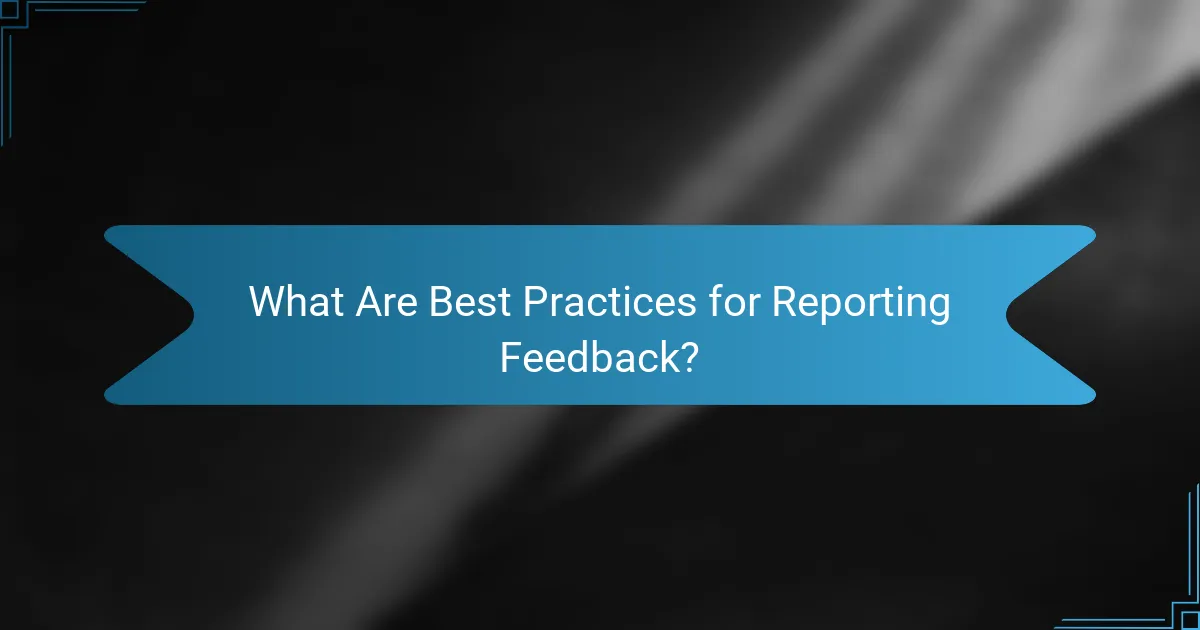
What Are Best Practices for Reporting Feedback?
Best practices for reporting feedback involve clear communication, effective visualization, and concise summaries that cater to the audience’s needs. Utilizing various reporting methods enhances understanding and facilitates informed decision-making.
Visual Dashboards
Visual dashboards provide a real-time overview of feedback data, making it easier to identify trends and insights at a glance. They typically include graphs, charts, and key performance indicators (KPIs) that summarize stakeholder sentiments and engagement levels.
When creating a visual dashboard, focus on clarity and relevance. Use color coding to indicate positive, neutral, and negative feedback, and ensure that the most critical metrics are prominently displayed. Tools like Tableau or Power BI can help in designing effective dashboards.
Executive Summaries
Executive summaries distill complex feedback into concise reports that highlight key findings and recommendations. These summaries should be tailored for decision-makers, focusing on actionable insights rather than detailed data.
To craft an effective executive summary, start with an overview of the feedback collected, followed by major themes and suggested actions. Aim for one to two pages, ensuring that the language is straightforward and free of jargon. Bullet points can help emphasize critical information.
Stakeholder Presentations
Stakeholder presentations are an opportunity to engage directly with your audience, presenting feedback findings in an interactive format. These sessions should encourage discussion and allow stakeholders to ask questions and provide input on the findings.
When preparing a presentation, structure it to cover the context of the feedback, the main insights, and proposed actions. Use visuals to support your points, and practice delivering the content clearly and confidently. Aim for a duration of 20-30 minutes, leaving time for Q&A at the end.

What Criteria Should Be Considered for Feedback Collection?
When collecting feedback, it is essential to consider the target audience, the objectives of the feedback, and the resources available for the collection process. These criteria help ensure that the feedback gathered is relevant, actionable, and feasible within the given constraints.
Target Audience
Identifying the target audience is crucial for effective feedback collection. This group should include stakeholders who are directly impacted by the project or initiative, such as customers, employees, or partners. Understanding their demographics, preferences, and behaviors can guide the selection of appropriate feedback methods.
For instance, if the feedback is aimed at improving a product for young adults, using social media surveys may be more effective than traditional email questionnaires. Tailoring the approach to the audience increases the likelihood of obtaining valuable insights.
Feedback Objectives
Clearly defining feedback objectives helps focus the collection process. Objectives may include assessing satisfaction, identifying areas for improvement, or gathering ideas for new features. Establishing specific goals allows for targeted questions that yield actionable data.
For example, if the objective is to enhance customer service, questions should revolve around response times and service quality. This clarity ensures that the feedback collected directly aligns with the desired outcomes.
Resource Availability
Resource availability encompasses the budget, time, and personnel allocated for feedback collection. Understanding these limitations is vital for selecting appropriate methods. For instance, extensive surveys may require more time and financial investment compared to quick polls or informal interviews.
It is advisable to prioritize methods that fit within available resources while still achieving the feedback objectives. A common pitfall is overextending resources on complex collection methods when simpler approaches could suffice, leading to wasted efforts and incomplete data.

How to Choose the Right Feedback Collection Tools?
Selecting the right feedback collection tools involves assessing your specific needs, the features offered, and how well they integrate with your existing systems. Consider your audience and the type of feedback you seek to ensure the tools align with your objectives.
Tool Features
When evaluating feedback collection tools, focus on essential features such as survey customization, response tracking, and data analysis capabilities. Look for tools that allow you to create various question types, including multiple-choice, open-ended, and rating scales to gather diverse insights.
Additionally, consider features like automated reminders, real-time reporting, and mobile compatibility to enhance response rates and accessibility. Tools that offer visual data representation can help you quickly interpret feedback trends.
Integration Capabilities
Integration capabilities are crucial for streamlining your feedback process. Ensure the tools you choose can easily connect with your existing software, such as CRM systems, email marketing platforms, or project management tools. This connectivity allows for seamless data flow and reduces manual entry.
Check if the tools support APIs or have pre-built integrations with popular applications. This can save time and enhance the overall efficiency of your feedback collection and analysis efforts.
User Experience
A positive user experience is vital for encouraging participation in feedback collection. Choose tools with intuitive interfaces that are easy for both administrators and respondents to navigate. A straightforward design can help minimize confusion and increase response rates.
Consider the mobile-friendliness of the tool, as many users prefer to provide feedback via their smartphones. Tools that offer responsive design and quick loading times will likely yield better engagement.

What Are Common Challenges in Stakeholder Feedback Collection?
Common challenges in stakeholder feedback collection include low response rates, biased feedback, and difficulties in reaching diverse stakeholder groups. These issues can hinder the effectiveness of feedback processes and lead to incomplete or skewed data.
Low Response Rates
Low response rates can significantly impact the quality of stakeholder feedback. Factors contributing to this challenge include survey fatigue, unclear questions, and lack of incentives. To improve response rates, consider simplifying surveys, clearly communicating the purpose, and offering small rewards.
Biased Feedback
Biased feedback often arises from leading questions or a non-representative sample of stakeholders. This can distort the insights gathered and lead to misguided decisions. To mitigate bias, use neutral language in surveys and ensure a diverse group of stakeholders is invited to participate.
Difficulties in Reaching Diverse Stakeholder Groups
Engaging a wide range of stakeholders can be challenging due to geographic, cultural, or technological barriers. For instance, stakeholders in remote areas may lack access to online surveys. To address this, utilize multiple channels for feedback collection, such as in-person meetings, phone interviews, and online platforms, ensuring inclusivity across demographics.
